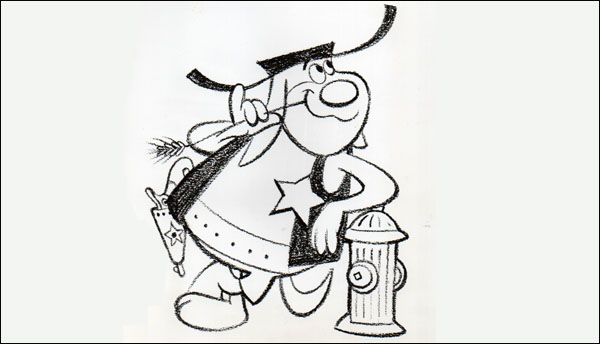
While researching the development of Deputy Dawg (see The Secret Origin of Deputy Dawg), we came across numerous documents and articles relating to the series. For this post we wanted to share some of our findings relating to the series.
First off is this newspaper article about the show’s production. This is reprinted from The Charlotte News, December 10, 1960:
At Hard Labor: Hundreds Of Men Put In Hundreds Of Hours Creating A Single Cartoon
Each cartoon in the new Deputy Dawg series, although it lasts only give and one-half minutes on the TV screen, requires nearly 2,100 man-hours of labor at the Terrytoons animation studio in New Rochelle, N.Y., the largest such studio in the eastern U.S.
There, 100 writers, directors, animators, background artists, musicians, colorers and actors work approximately three months to produce each Deputy Dawg cartoon.
It’s true that not all 100 people are working all the time, but the process of production is such that at least 90 days pass between the time the story department’s idea is okayed and the film is finished. In the early days of cartoon making, the same process took nearly a year.
Today’s animated cartoons are much more sophisticated than they were 25 years ago.
“The audience used to roat if the cartoon figure just moved,” recalls William Weiss, vice president of Terrytoons and executive producer of Deputy Dawg, which is seen on WSOC-TV, Thursdays at 6 p.m.
“Today’s audience want good design. They want richer characterization. They want gags to grow out of a naturally funny story.”
Music for each cartoon is composed by Phillip Scheib, a Terrytoons veteran, who can provide music that goes from medieval to rock ‘n’ roll. For Deputy Dawg, he builds his music around a harmonica.
The man who does all the Deputy Dawg voices is Dayton Allen, the comedian who played the “Why Not?” role in Steve Allen’s TV shows.
Allen has built up his own library of different accents and recognizable types – he can do anything called for “within reason,” he says. “And then they went and put a mouse from outer space, a Russian yet, into the script!”
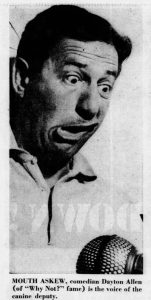
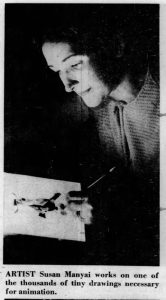
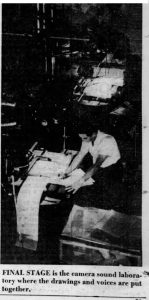
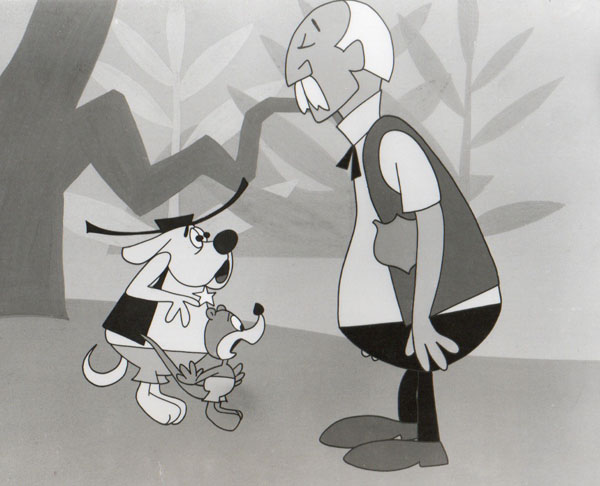
According to the show’s original TV press kit, this still photo is supposedly from “Space Varmint”. Maybe the background is, but I don’t see any of these cels in the film – and the Sheriff is no where to be seen.
In addition to articles like these, cartoon historian Jerry Beck has dug up paperwork relating to the series. Most crucially, credits sheet for all 104 Deputy Dawg cartoons, listing writers, directors, and animators, were found.
These credits sheet are fascinating for a number of reasons. In order to produce all the episodes in a short span of time, outside freelancers were hired, including West Coast talent like former Disney writing team Al Bertino and Dick Kinney, as well as animators Art Davis and Alan Zaslove. Other people hired includes Bill Tytla, a journeyman animator who has worked for Terrytoons in the past, and Jack Mercer, long-time story man and voice actor for Fleischer Studios and Famous Studios.
We will reproduce the credits sheets in the bottom of this post, but in the meantime, we thought we’d highlight individual episodes of the show.
Space Varmint (1960)
Prod. 659
Director: Connie Rasinski
Story: Larz Bourne
The second cartoon made, according to the production code. This is the first of several to feature a space alien character before he was retooled and given his own theatrical series in 1964, now named Astronut. The Astronut Show would debut in syndication the following year in 1965.
Scholar David Gerstein noted that this cartoon has more obvious redubs, including the scene where Deputy Dawg jumps on Musky in a violent fashion, with Deputy saying he’s sorry he has to do it, even though this clearly wasn’t intended in the animation seen on-screen. The redub was easier to achieve because Deputy’s back is turned, thus not having to worry about lip sync.
Star For A Day (1960)
Prod. 706
Director-Animator: Connie Rasinski
Story: Al Bertino, Dick Kinney
The last of the Bertino-Kinney written shorts, which features Musky and others trying to get Deputy Dawg hired by a talent agent so he would be out of their hairs while raiding the hen house.
This is an example of Terrytoons recycling old model sheets. The talent agent featured bears a strong resemblance to the owner of the seal that appeared in the Clint Clobber cartoon Signed, Sealed, and Clobbered.
Peanut Pilferer (1961)
Prod. 743
Director: Bill Tytla
Animator: George Bakes
Story: Larz Bourne
One of the TV cartoons directed by Bill Tytla, who began his association with Paul Terry when he worked on the Aesop’s Fables cartoons back in the 1920s. The animation in this cartoon, by George Bakes, is noticeably stronger than most Deputy Dawg shorts. Of a particular note is the repeated animation of the elephant sucking up peanuts like a vacuum cleaner.
Double-Barreled Boom Boom (1964)
Prod. 807
Director: Art Bartsch
Story: Larz Bourne
Animator: Art Davis
A hypnotist’s hunting trip is thwarted by Long Island Duckling, a recurring beatnik character. The character was later given his own short-lived series, now called “Duckwood”, who appeared in three theatrical cartoons released in 1964.
This is one of the small number of TV cartoons from Terrytoons that was freelanced out to West Coast animators, in this case Art Davis, whose older brother, Mannie, worked on Deputy Dawg as a director and animator. This technically made Deputy Dawg the first time that both brothers worked on the same project since the 1920s. Art Davis, of course, has built a career at West Coast studios; by the 1960s he was working for Hanna-Barbera and Walter Lantz before moving to DePatie-Freleng as a director.
Around this time the running time has shrunk, going from 5.5 minutes to 4.5 minutes. As a result, the later stories has a more compact feel compared to the earlier ones.
Show Biz Whiz (1964)
Prod. 814
Director-Animator: Ralph Bakshi
Story: Jack Mercer
It was fitting for Jack Mercer to write this story about a show-biz bird blackmailing the Deputy by impersonating his voice to the Sheriff, given that Mercer himself had a knack for voice acting and impersonations.
Ralph Bakshi owes his career to Deputy Dawg, having gotten his first taste in animating with this series. Later in the run he was given a chance to direct a handful of episodes, this being one of them. Bakshi’s animation for the series stands out in a number of ways, one of which is that he often drew Vincent Van Gopher with wide-open eyes, this cartoon being no exception.
Below: From the files at Viacom, a complete list of all the Deputy Dawg cartoons, in production order, with their production numbers, director, story man and animator credits. Click to enlarge. Below that, a mock-up sample of Deputy Dawg newspaper advertising.
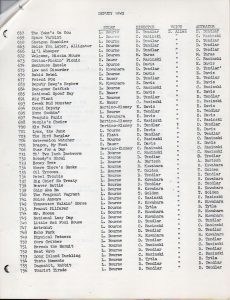
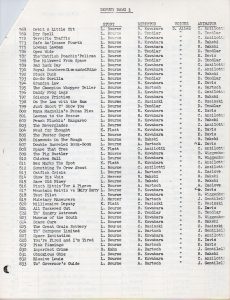
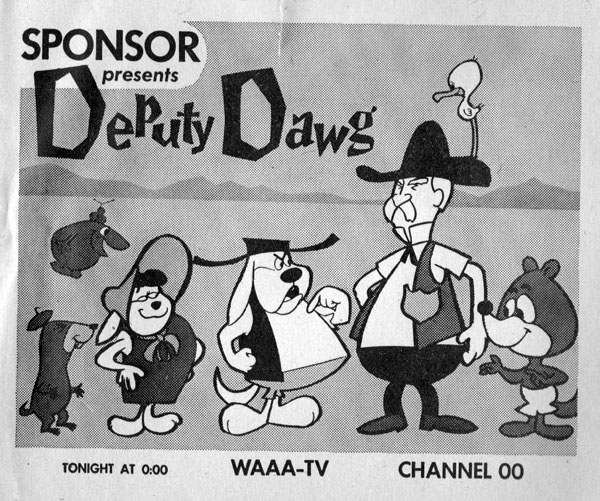
(Special thanks to Jerry Beck and Mike Kazaleh for their contributions to this post)


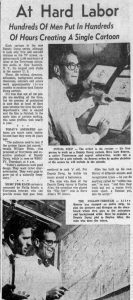
 Charles Brubaker is a cartoonist originally from Japan. In addition to his work for MAD Magazine and SpongeBob Comics, he also created Ask a Cat for GoComics. You can also follow him on his Tumblr page.
Charles Brubaker is a cartoonist originally from Japan. In addition to his work for MAD Magazine and SpongeBob Comics, he also created Ask a Cat for GoComics. You can also follow him on his Tumblr page.











































In those earliest cartoons, namely the first eight entries. DD’s nose in big black and round, an his fur is bluish white.
I know his redesign was gradual. By what epiosde was his final design -small red nose, and solid white fur which is the design most people know finalized?
Any answer whould be appreciated.
-Chris
Years ago I read that Bill Tytla directed some Deputy Dawg cartoons, but I never knew which ones. It’s nice, though also a bit sad, to see some faint vestiges of his former greatness in “Peanut Pilferer”. Of course, he had had some prior experience in animating elephants….
Charles, Jerry:
Thank you for all of the rare and, yes, fascinating Dawg data and Terrytoons scholarship. Most appreciated.
That’s amazing! I had no idea Art Davis animated an episode of Deputy Dawg, he’s one of my favorite animators. It’s so interesting see all sorts of names, I still stand that Deputy Dawg is more creative then the west coast TV shows of the day. So much mileage they got out of those characters
Interesting to see good old Johnny G doing some animation there at Terrytoons.
What a great read – thank you for sharing!! I grew up watching ol’ D.D. in the 1970’s on WSNS-44 in Chicago before it changed to a Telemundo affiliate.
The “Wiggenhorn” listed as animator on some later episodes was Bard Wiggenhorn, who also worked for UPA’s New York operation. He was one of the animators on Chris Ishii and Jack Goodford’s “Terror Faces Magoo”. Interesting find that Terry farmed out work to the Coast; wonder who else besides Art Davis and Alan Zaslove would have worked on them?
We’ll hopefully do a post exploring it in-depth, but we do know that one of the “Hector Heathcote” cartoons was directed by George Gordon, who was working in Hollywood at this point.
Terrytoons also hired West Coast writers for stories, including Bertino & Kinney, Kin Platt, Chris Jenkyns, and Bob Ogle.
The list posted here seems to be just one page of the entire series roster. Any chance we could get to see the complete list? I’m curious to know if Marty Taras shows up anywhere in it, assuming he had any involvement with the series.
There no chance – because there isn’t anymore to it than this. I acquired these when I worked for Viacom back in the 1990s. I have them for several Terrytoon TV series – and this is all the information they contain.
Marty Taras directed one episode, “Welcome Mischa Mouse”, production 672
https://www.youtube.com/watch?v=PgikkL1cmiM
Bertino & Kinney were really cranking out the scripts in 1960–Working on the TV Popeyes and Mister Magoos as well as DD.
I liked this show as a kid back in the 70s. It’s very cool to see it again. I like seeing anything about Terrytoons here too.